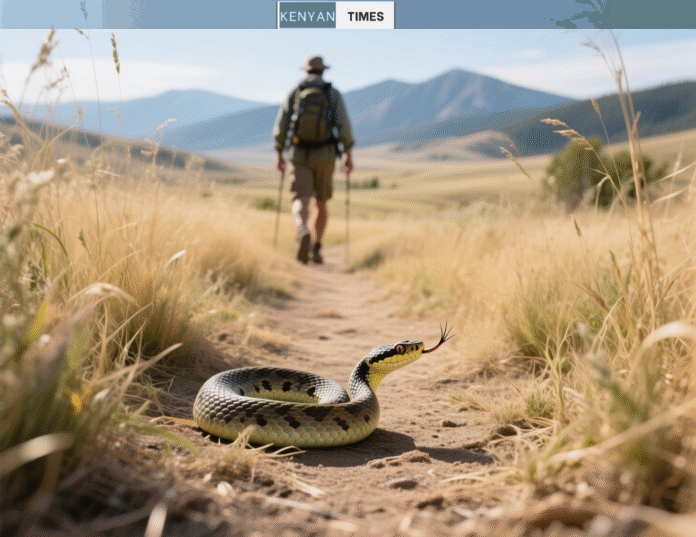Table of Contents
- 1 Are There Rattlesnakes in Montana? What You Need to Know Before You Hike
- 1.1 🐍 Yes, Rattlesnakes Live in Montana
- 1.2 📏 How Big Are They?
- 1.3 ⚠️ Are Rattlesnakes in Montana Dangerous?
- 1.4 🥾 How to Stay Safe in Rattlesnake Country
- 1.5 🐾 What to Do If You Encounter a Rattlesnake
- 1.6 🧠 Fun Fact
- 1.7 🏞️ Rattlesnakes and Montana’s Outdoor Life
- 1.8 🔗 Related Articles You Might Like:
- 1.9 🧭 Final Thoughts: Should You Worry?
Are There Rattlesnakes in Montana? What You Need to Know Before You Hike
If you’re planning a hike, camping trip, or any outdoor adventure in Montana, you may be wondering: Are there rattlesnakes in Montana? The answer is yes, but they’re not as widespread or aggressive as you might fear.
Montana’s beautiful, rugged terrain is home to some fascinating—and occasionally dangerous—wildlife. Among them is the prairie rattlesnake, the only venomous snake native to the state. This article breaks down where these snakes are found, what to do if you encounter one, and how to stay safe during your outdoor adventures.
🐍 Yes, Rattlesnakes Live in Montana
Montana is home to one species of rattlesnake: the prairie rattlesnake (Crotalus viridis). While you won’t find these snakes slithering down the streets of Missoula or Bozeman, they are common in the eastern and central parts of the state—particularly in dry, rocky, and grassy areas.
Where You’re Most Likely to See One:
- Eastern Montana badlands
- Missouri River Breaks
- Along hiking trails near Billings and Miles City
- Grasslands and open prairies
If you’re hiking in Yellowstone County or exploring the High Plains, it’s smart to be cautious.
📏 How Big Are They?
Prairie rattlesnakes typically grow between 2.5 to 4 feet long, with a thick body and a distinctive rattle at the tip of their tail. Their coloring blends well with dry grass and dirt, which makes them harder to spot until you’re close.
⚠️ Are Rattlesnakes in Montana Dangerous?
Like all rattlesnakes, they are venomous, and a bite can be dangerous if not treated promptly. However, they are not naturally aggressive and typically strike only when threatened.
According to Mayo Clinic’s guide to snake bites, immediate treatment is essential. Fortunately, rattlesnake bites are rare in Montana, and fatalities are extremely uncommon due to modern medical care.
🥾 How to Stay Safe in Rattlesnake Country
If you’re hiking, hunting, or camping in areas known for rattlesnakes, follow these safety tips:
- Wear boots and long pants when hiking.
- Stay on well-used trails and avoid tall grass or rocky outcrops.
- Listen for the rattle—it’s their warning signal.
- Never try to handle or kill a rattlesnake—most bites occur this way.
- Carry a flashlight at night to see where you’re walking.
- Keep dogs leashed in snake-prone areas.
Want more tips for hiking safely in Montana? Check out Visit Montana’s safety guide.
🐾 What to Do If You Encounter a Rattlesnake
- Stop immediately if you hear a rattle.
- Back away slowly—don’t run or make sudden movements.
- Give the snake space and let it retreat.
- If bitten, stay calm and get medical help fast. Do not cut the bite or suck out venom.
🧠 Fun Fact
Prairie rattlesnakes are important to the ecosystem. They control rodent populations, and like many wild animals, they generally avoid humans when possible.
🏞️ Rattlesnakes and Montana’s Outdoor Life
Don’t let fear of snakes keep you from enjoying Montana’s incredible parks and landscapes. Being informed is the best way to stay safe. In fact, locals and frequent hikers rarely encounter snakes when staying alert and following basic precautions.
For a deeper dive into Montana’s reptiles and amphibians, visit the Montana Field Guide.
🔗 Related Articles You Might Like:
Best Hikes in Rattlesnake-Free Zones
❓ FAQs
1. What kind of rattlesnakes live in Montana?
Montana is home to the prairie rattlesnake (Crotalus viridis), the only venomous snake species native to the state.
2. Are rattlesnakes common in all parts of Montana?
No, they are most common in eastern and central Montana, especially in dry, rocky areas and open prairies.
3. What should I do if I see a rattlesnake?
Stay calm, don’t approach it, and back away slowly. Rattlesnakes prefer to avoid humans and will usually retreat if given space.
4. How dangerous are rattlesnake bites in Montana?
Bites are rare and rarely fatal. However, if bitten, seek medical attention immediately for the best outcome.
5. Can I hike safely in Montana’s rattlesnake zones?
Yes! Wear boots, stay on trails, and remain alert. Most hikers never encounter snakes when following safety guidelines.
🧭 Final Thoughts: Should You Worry?
So, are there rattlesnakes in Montana? Yes—but they’re not common in most populated or high-traffic areas, and bites are rare. With some basic awareness and respect for nature, you can explore Big Sky Country with confidence.
Montana’s wild beauty comes with a bit of risk—but it’s what makes the experience so authentic. Prepare well, and enjoy your time outdoors!




